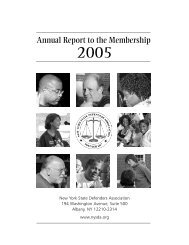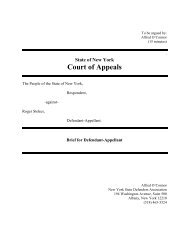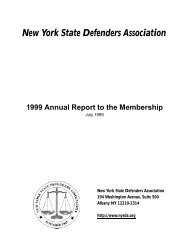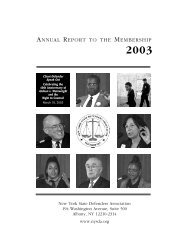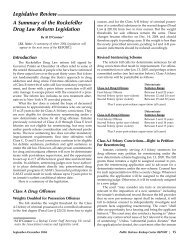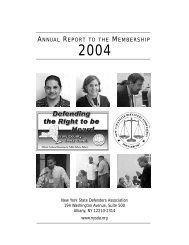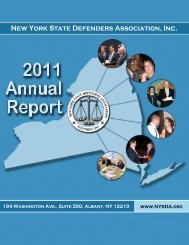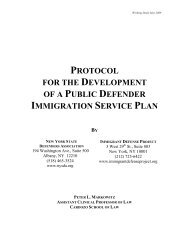Quick Reference Chart for Determining Immigration Consequences ...
Quick Reference Chart for Determining Immigration Consequences ...
Quick Reference Chart for Determining Immigration Consequences ...
You also want an ePaper? Increase the reach of your titles
YUMPU automatically turns print PDFs into web optimized ePapers that Google loves.
APPENDIX A: QUICK REFERENCE CHART FOR DETERMINING IMMIGRATION CONSEQUENCES OF COMMON NEW YORK OFFENSES<br />
Loitering<br />
Violation<br />
Offense<br />
Loitering, 1st<br />
degree<br />
Class B<br />
misdemeanor<br />
Loitering <strong>for</strong> the<br />
purpose of<br />
engaging in a<br />
prostitution offense<br />
Violation<br />
Class B<br />
misdemeanor<br />
Class A<br />
misdemeanor<br />
NYPL<br />
Section<br />
Aggravated<br />
Felony (AF)?<br />
Crime Involving<br />
Moral Turpitude<br />
(CIMT)?<br />
240.35 No. Convictions<br />
under<br />
subsections (2)<br />
and (3) might be<br />
CIMT.<br />
Other Grounds?:<br />
Controlled Substance (CSO)<br />
Crime Against Child (CAC)<br />
Dom. Violence (CODV) etc.<br />
Firearm Offense (FO)<br />
Prostitution<br />
Commercialized Vice<br />
240.36 No. Might be CIMT. Might be CSO if record of<br />
conviction establishes a<br />
controlled substance as<br />
defined in 21 USC 802.<br />
240.37 No. Maybe. Might trigger “prostitution”<br />
inadmissibility.<br />
Comments, Strategies & Tips<br />
These are by no means an exhaustive list of strategies and tips<br />
advocates may pursue. For additional defense lawyer strategies,<br />
see Chapter 5. For additional immigration lawyer strategies, see<br />
Appendix K.<br />
240.26) and, if that also is not possible, Aggravated<br />
Harassment, 2 nd (see above, PL 240.30).<br />
Tip <strong>for</strong> defense lawyers:<br />
1. To avoid CIMT risk, avoid subsections (2) and (3).<br />
Tip <strong>for</strong> defense lawyers:<br />
1. To avoid CSO or CIMT risks, consider obtaining an<br />
adjournment in contemplation of dismissal (ACD) or<br />
alternative offenses such as Disorderly Conduct,<br />
Trespass or Loitering (see above, PL 240.20, 140.05 &<br />
240.35).<br />
2. If pleading to this offense cannot be avoided, if<br />
possible, keep out of record of conviction identification of<br />
the controlled substance involved.<br />
Tip <strong>for</strong> defense lawyers:<br />
1. To avoid risk of “prostitution” inadmissibility (and, if<br />
client has prior CIMT, to avoid CIMT deportability or<br />
inadmissibility), if possible consider obtaining an<br />
adjournment in contemplation of dismissal (ACD) or an<br />
alternative offense such as Disorderly Conduct, Trespass<br />
or Loitering (see above, PL 240.20, 140.05 & 240.35).<br />
Tip <strong>for</strong> immigration lawyer:<br />
1. Argue that just one or a few loitering convictions<br />
cannot trigger “prostitution” inadmissibility. The BIA has<br />
held that to “engage in” prostitution, one must have<br />
engaged in a regular pattern of behavior or conduct. See<br />
Matter of T, 6 I&N Dec.474 (BIA 1955) (holding that the<br />
noncitizen who was twice convicted <strong>for</strong> committing acts<br />
of prostitution was not excludable); Matter of R, 2 I&N<br />
Dec. 50 (BIA 1944) (single act <strong>for</strong> gain under<br />
circumstances showing prostitution).<br />
NYSDA IMMIGRANT DEFENSE PROJECT, December 2006 A-87



